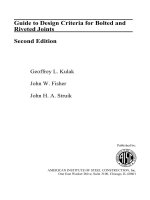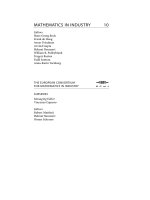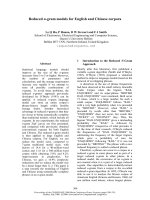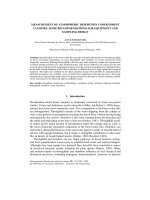smart card applications design models for using and programming smart cards
Bạn đang xem bản rút gọn của tài liệu. Xem và tải ngay bản đầy đủ của tài liệu tại đây (2.04 MB, 238 trang )
Smart Card Applications
Smart Card Applications
Design Models for using and
programming smart cards
Wolfgang Rankl
Giesecke & Devrient GmbH, Germany
Translated by
Kenneth Cox
Kenneth Cox Technical Translations, Wassenaar, The Netherlands
Authorised Translation from the German language edition published by Carl Hanser Verlag.
Copyright 2007 John Wiley & Sons Ltd, The Atrium, Southern Gate, Chichester,
West Sussex PO19 8SQ, England
Telephone (+44) 1243 779777
Email (for orders and customer service enquiries):
Visit our Home Page on www.wileyeurope.com or www.wiley.com
All Rights Reserved. No part of this publication may be reproduced, s tored in a retrieval system or
transmitted in any form or by any means, electronic, m echanical, photocopying, recording, scanning or
otherwise, except under the terms of the Copyright, Designs and Patents Act 1988 or under the terms of a
licence issued by the Copyright Licensing Agency Ltd, 90 Tottenham Court Road, London W1T 4LP, UK,
without the permission in writing of the Publisher. Requests to the Publisher should be addressed to the
Permissions Department, John Wiley & Sons Ltd, The Atrium, Southern Gate, Chichester, West Sussex
PO19 8SQ, England, or emailed to , or faxed to (+44) 1243 770620.
Designations used by companies to distinguish their products are often claimed as trademarks. All brand
names and product names used in this book are trade names, service marks, trademarks or registered
trademarks of their respective owners. The Publisher is not associated with any product or vendor mentioned
in this book.
This publication is designed to provide accurate and authoritative information in regard to the subject matter
covered. It is sold on the understanding that the Publisher is not engaged in rendering professional services.
If professional advice or other expert assistance is required, the services of a competent professional should
be sought.
Other Wiley Editorial Offices
John Wiley & Sons Inc., 111 River Street, Hoboken, NJ 07030, USA
Jossey-Bass, 989 Market Street, San Francisco, CA 94103-1741, USA
Wiley-VCH Verlag GmbH, Boschstr. 12, D-69469 Weinheim, Germany
John Wiley & Sons Australia Ltd, 42 McDougall Street, Milton, Queensland 4064, Australia
John Wiley & Sons (Asia) Pte Ltd, 2 Clementi Loop #02-01, Jin Xing Distripark, Singapore 129809
John Wiley & Sons Canada Ltd, 6045 Freemont Blvd, Mississauga, Ontario, L5R 4 J3, Canada
W iley also publishes its books in a variety of electronic formats. Some content that appears
in print may not be available in electronic books.
Anniversary Logo Design: Richard J. Pacifico
British Library Cataloguing in Publication Data
A catalogue record for this book is available from the British Library
ISBN 978-0-470-05882-4 (HB)
Typeset in 10/12 Times by Laserwords Private Limited, Chennai, India
Printed and bound in Great Britain by Antony Rowe Ltd, Chippenham, Wiltshire
This book is printed on acid-free paper responsibly manufactured from sustainable forestry
in which at least two trees are planted for each one used for paper production.
Contents
Foreword xi
SymbolsandNotation xiii
Abbreviations xv
1 OverviewofSmartCards 1
1.1 CardClassification 1
1.2 CardFormats 2
1.3 CardElements 3
1.3.1 Printing and labelling . 3
1.3.2 Embossing 4
1.3.3 Hologram 4
1.3.4 Signaturepanel 4
1.3.5 Tactile elements 4
1.3.6 Magneticstripe 4
1.3.7 Chip module . . 5
1.3.8 Antenna 5
1.4 SmartCardMicrocontrollers 5
1.4.1 Processor 8
1.4.2 Memory 8
1.4.3 Supplementary hardware 8
1.4.4 Electricalcharacteristics 9
2 SmartCardOperatingSystems 11
2.1 FileManagement 11
2.1.1 Filetypes 12
2.1.2 Filenames 12
2.1.3 Filestructures 13
vi
2.1.4 Fileattributes 15
2.1.5 Fileselection 15
2.1.6 Access conditions . 16
2.1.6.1 State-based access conditions . 16
2.1.6.2 Rule-based access conditions . 17
2.1.7 Filelifecycle 18
2.2 Commands 19
2.3 DataTransmission 22
2.3.1 AnswertoReset(ATR) 23
2.3.2 Protocol Parameter Selection ( PPS) . . . 24
2.3.3 Transmissionprotocols 24
2.3.3.1 T=0transmissionprotocolforcontactcards 25
2.3.3.2 T=1transmissionprotocolforcontactcards 25
2.3.3.3 USBtransmissionprotocolforcontactcards 25
2.3.3.4 Contactlesstransmissionprotocols 26
2.3.4 SecureMessaging 26
2.3.5 Logicalchannels 26
2.4 SpecialOperatingSystemFunctions 26
2.4.1 Cryptographicfunctions 27
2.4.2 Atomicprocesses 28
2.4.3 Interpreter 28
2.4.4 Applicationmanagement 28
3 ApplicationAreas 31
3.1 SmartCardSystems 31
3.2 PotentialUses 32
3.3 ApplicationTypes 33
3.3.1 Memory-basedapplications 33
3.3.2 File-basedapplications 33
3.3.3 Code-basedapplications 35
4 BasicPatterns 37
4.1 DataProtection 37
4.1.1 Definition of terms . 38
4.1.2 Generalprinciples 39
4.1.3 Recommendationsforsmartcardsystems 40
4.1.4 Summary 43
vii
4.2 Export Control . 44
4.3 CryptographicRegulation 46
4.4 Standards 47
4.4.1 Standards for card bodies . . . . . . 48
4.4.2 Standardsforoperatingsystems 48
4.4.3 Standardsfordataanddatastructuring 49
4.4.4 Standards for computer interfaces . . 49
4.4.5 Standardsforapplications 49
4.5 DocumentsforSmartCardSystems 50
4.5.1 Specification partitioning 52
4.5.1.1 Systemspecification 52
4.5.1.2 Background system specification . 52
4.5.1.3 Smartcardspecification 53
4.5.1.4 Terminalspecification 54
4.5.2 Elementsofatypicalcardspecification 54
4.5.2.1 Generalinformation 54
4.5.2.2 Smartcard 55
4.5.2.3 Smartcardoperatingsystem 55
4.5.2.4 Application 56
4.5.3 Documentdistribution 58
4.5.4 Documentversionnumbering 59
5 ArchitecturePatterns 61
5.1 Data 61
5.2 DataCoding 62
5.3 Files 63
5.3.1 Access conditions . . . 64
5.3.2 Filenames 67
5.4 LogFiles 67
5.4.1 Datastorage 67
5.4.2 Assigningdatatologfiles 68
5.4.3 Invoking logging 68
5.4.4 Access conditions for log files . . . . 68
5.4.5 Logged data . . 69
5.4.6 Consistencyandauthenticityoflogdata 70
5.4.7 Logfilesize 71
5.4.8 Logging process 72
viii
5.5 Pairing 73
5.6 ProtectingTransactionData 74
5.7 Reset-proof Counters 77
5.8 Proactivity 77
5.9 Authentication Counter . . . 79
5.10ManualAuthenticationofaTerminal 81
5.11PINManagement 83
5.12One-timePasswords 84
5.13KeyManagement 88
5.14StateMachinesforCommandSequences 89
5.15SpeedOptimization 91
5.15.1 Computingpower 93
5.15.2 Communication 93
5.15.3 Commands 94
5.15.4 Dataandfiles 95
6 ImplementationPatterns 97
6.1 ApplicationPrinciples 97
6.1.1 Programcode 97
6.1.2 Commands 99
6.1.3 Data 99
6.1.4 Security 100
6.1.5 Applicationarchitecture 102
6.1.6 System 106
6.2 Testing 108
6.3 User–TerminalInterface 114
6.4 SmartCardCommands 115
6.4.1 Commandstructure 116
6.4.2 Interruptionofcommands 117
6.4.3 Commandcoding 118
6.4.4 Parameterization 118
6.4.5 Testcommands 119
6.4.6 Secretcommands 119
6.5 JavaCard 120
6.5.1 Datatypes 122
6.5.2 Arithmeticoperations 128
6.5.3 Controlstructures 129
ix
6.5.4 Methods 131
6.5.5 Applets 132
7 OperationPatterns 137
7.1 Initializatio n and Personalization 137
7.2 Migration 141
7.3 Monitoring 143
7.3.1 Systemintegrity 143
7.3.2 Attackdetection 144
8 PracticalAspectsofSmartCards 147
8.1 Acceptance . . . 147
8.2 Tell-taleSignsofDifficultSmartCardSystems 150
8.2.1 Inappropriateuseofsmartcards 150
8.2.2 Unclearspecifications 151
8.2.3 Abundant options 151
8.2.4 Piggyback applications . 152
8.2.5 Economizing on testing 153
8.2.6 Downloadingapplications 154
8.2.7 Offlinesystems 155
8.2.8 Intolerantsmartcardsandterminals 155
8.2.9 Strict compatibility requirements . . 156
8.2.10 Excessivelystringentsecurityrequirements 157
8.2.11 Exaggeratedfuture-proofing 158
8.3 PrerequisitesforEasySmartCardSystems 159
8.3.1 Expertadvice 159
8.3.2 Foresighteddesign 160
8.3.3 Prototyping 160
8.3.4 Single-applicationsmartcards 161
8.3.5 Simplestructures 161
8.3.6 Robust design . 161
8.3.7 Centralizedsystems 163
8.3.8 Stageddeployment 163
8.4 In-fieldFaults 164
8.4.1 Faultclassification 164
8.4.2 Faultimpact 165
8.4.3 Actions in response to a fault . . . . 167
x
8.4.4 Faultsearchprocedure 168
8.4.5 Faultremedies 170
9 IllustrativeUseCases 173
9.1 MonasteryCard 173
9.2 Access Card . 176
9.3 Telemetry Module . 184
9.4 BusinessCard 186
9.5 TheftProtectionCard 190
9.6 AdmissionPass 193
9.7 PKICard 196
9.8 SIMCard 198
Bibliography 203
Index 209
Foreword
There was a tremendous breakthrough mood in the smart card world in the mid-1990s.
The technology was seen to have reached a sufficient level of maturity and achieved
sufficient functio nality to enable a wide variety of security applications to be effectively
implemented. The largest application areas were electronic purse systems – with an as-
tonishing wealth of variants – and mobile communication systems, which were spreading
over the entire world.
Unfortunately, system operators were confronted with many problems after large numbers
of smart cards hosting these new, technically interesting smart card applications found
their way into the hands of end users. There were instances in which no terminals were
available for use by customers, and in some cases, system developers overlooked the
fact that customers have their own interests and needs and cannot be manipulated to
behave in a way that makes no sense to them.
Smart card technology has continued to develop unobtrusively in the meantime, and a
paradigm shift has occurred in parallel with this development. Technology has vanished
into the background as a driver for smart card applications, and its role as a guide to
the future has been taken over by the applications. User needs now occupy the focus of
attention. This is quite a normal cycle in the course of technology development, as has
been seen repeatedly in this form and in similar forms.
This new aspect of the situation inspired me to write this book, as the current trend is
to use smart cards on account of their positive characteristics instead of simply because
they exist.
My objective with this book is not to elaborate on the theoretical aspects of abstract
design models, but instead to concentrate on useful, proven solutions that can be im-
plemented directly using availab le smart card operating systems. More than 15 years of
professional experience with smart cards and their applications, as well as hundreds of
letters from readers I have received as one of the co-authors of the Smart Card Handbook,
have contributed to the creation of this book.
The design models described here are illustrated b y a large number of interesting
examples in order to maintain contact with real life. I have also intentionally included
examples of failed and otherwise unsuccessful projects, because such examples often
serve as excellent guides on how to do things better.
The central aim of this book is to describe reusable model solutions and modules that
can be used to handle commonly occurring tasks and can be presented independently of
actual program code. This is fully in accordance with the established method of breaking
xii Foreword
down a problem into smaller, subordinate problems that are easier to solve, developing
individual solutions to these subordinate problems, and then combining the individual
solutions to create an overall solution to the or iginal problem.
This book is neither a reformatted version of the Smart Card Handbook nor an abridged
version of that book, but instead a book that stands on it own and focuses on the subject
of smart card applications. The first two chapters provide a brief introduction to the
world of smart cards, but they address the underlying technology only to the extent
necessary for a proper understanding of the following chapters. If you are interested in
delving further in the technical details at any point, I take the opportunity here to refer
you to the Smart Card Handbook.
I would like to express my thanks to the following people: Dieter Weiß for frequent and
long discussions on the interpretation of ISO standards, Ralf Holly and Martin R¨osner
for many helpful tips on programming Java cards, Christoph Schiller for convincing me
to use L
A
T
E
X, Sylvia Bernecker for the wonderful griffin, which looks just as I always
imagined it but could never manage to realize on paper, Kenneth Cox for the translation,
and of course Alexandra Rankl for her patience, without which I could never have written
this book.
Munich, Spring 2006
Wolfgang Rankl
www.WRankl.de
Symbols and Notation
– The least significant bit is designated as bit 1 in conformance with ISO nomenclature.
– I n concatenated data elements, the higher-order byte is located at the start o f the string
and the lower-order byte is located at the end – the data format is thus big endian.
– The term ‘byte’ corresponds to its meaning in common usage and means a series of
eight bits.
– T he lengths of data elements and objects and all countable quantities are stated in
decimal notation.
– When used in connection with data or memory sizes, the prefixes ‘kilo’, ‘mega’ and
‘giga’ have the values 1024 (2
10
), 1 048 576 (2
20
), and 1 073 741 824 (2
30
) respec-
tively. Similarly, the symbols ‘KB’, ‘MB’, and ‘GB’ designate 1024, 1 048 576, and
1 073 741 824 bytes.
– Binary values are u sed in a context-depend e nt manner and are n ot always explicitly
identified as such.
– Smart card commands are set in upper-case letters (e.g. SELECT FILE).
– As a rule, only the positive results are shown in sequence charts.
Representation of Characters and Numbers
0, 1 Binary value (used according to context)
8 Decimal value
'00' Hexadecimal value
''ABC'' ASCII value
bn Bit number n (e. g. b8)
Bn Byte number n (e. g. B1)
Dn Digit number n (e. g. D3)
Logical Functions and Program Code
= Assignment operator (also used as an comparison operator depending
on the context)
=, =,<,>,≤, ≥ Comparison operators
xiv Symbols and Notation
+, −, ·, / Arithmetic operators
Concatenation operator (e.g. for two data elements)
References
See‘ ’ This is a reference to another location in the book.
(N Y) or N (Y) This is a reference to a document or Internet site listed in the bibliog-
raphy. For documents with identified authors, ‘N’ is the last name of
the first author listed in the bibliography and ‘Y’ is the year of publi-
cation. References to Internet sites and documents without identified
authors are generally shown as unique abbreviations or organization
names without a year.
Functions
e = C(m) Calculate the error detection code e of the message m.
t = T(d) Structure data d using TLV coding. The result is the
TLV-coded data t.
p = P(d, v, l) Pad data d to a integer block length l using the value
or method v. The result is the padded data p.
c = E(p, k) Encrypt plain text p using a symmetric cryptographic
algorithm and the key k. The result is the cipher text c.
p = D(c, k) Decrypt cipher text c using a symmetric cryptographic
algorithm and the key k. The result is the plain text p.
a = M(m, k) Calculate the message authentication code (MAC) of
the message m using the secret key k.
s = S(m, sk) Sign the message m using the secret key sk.
r = V(m, s, pk) Verifying the signature s of the message m using the
public key pk. The result is ‘true’ or ‘false’.
h = H(m) Calculate the hash value h of the message m.
C=(A, pk
A
,S(A pk
A
,sk
CA
)) Generate the certificate C of the public key pk
A
of user
A. The certificate is signed using the secret key sk
CA
of the certification authority CA.
r=V(A pk
A
,C,pk
CA
) Verify the certificate C of the public key pk
A
of user A
using the public key pk
CA
of the certification authority
CA. The result is ‘true’ or ‘false’.
Abbreviations
3DES Triple DES (data encryption standard)
3GPP 3
rd
Generation Partnership Project
ADK additional decryption key
ADN abbreviated dialling number
AES Advanced Encryption Standard
AID application identifier
API application p rogramming interface
ARM Advanced RISC Machine
ARR access rule reference
ASCII American Standard Code for Information Interchange
ASN.1 Abstract Syntax Notation One
AT attention
ATR answer to reset
AUX1, AUX2 Auxiliary 1, Auxiliary 2
BAFA Bundesamt f¨ur Wirtschaft und Ausfuhrkontrolle
(German Federal Office of Economics and Export Control)
BCD binary coded digit
BNA Bundesnetzagentur (German Federal Network Agency)
BSI Bundesamt f¨ur Sicherheit in der Informationstechnik
(German Federal Office for Information Security)
CCS cryptographic checksum
CDMA code div ision multiple access
CEN Comit´e Europ´een de Normalisation
(European Committee for Standardization)
CHV card holder verification information
CICC contactless integrated chip card
CLA class
CLK clock
CPU central processing unit
CRC cyclic redundancy code
DES Data Encryption Standard
DF dedicated file
DO data object
DPA differential power analysis
xvi Abbreviations
DSA digital signature algor ithm
DSS Digital Signature Standard
EC elliptic curve crypto algorithm
ECC elliptic curve cryptosystem
ECC error correction code
ECDSA elliptic curve digital signature algorithm (DSA)
EDC error detection code
EEPROM electrical erasable program read-only memory
EF elementary file
EMV Europay MasterCard Visa
ETSI European Telecommunications Standard s Institute
etu elementary time unit
GND ground (electrical)
GNU GNU is not Unix
GPL GNU General Pub lic License
GUI graphical user interface
HMAC keyed-hash message authentication code (MAC)
HTML hypertext markup language
I/O input/output
IBE identity-based encryption
ICAO International Civil Aviation Organization
ICC integrated chip card
ID identifier
IEC International Electrotechnical Commission
IFD interface device
IMSI international mobile subscrib er identity
INS instruction
IPR intellectual property rights
ISO International Organization for Standardization
ITU International Telecommunications Union
JC Java Card
JCP Java Community Process
JCRE Java Card runtime environment
JIT just in time
JSR Java specification request
L
c
length command
L
e
length expected
MAC message authentication code
MD5 Message Digest Algorithm 5
MF master file
MIPS microprocessor without interlocked pipeline stages
NOP no operation
NPU numeric processing unit
Abbreviations xvii
NVM nonvolatile memory
OCF open card framework
OCR optical character recognition
P1, P2, P3 Parameter 1, Parameter 2, Parameter 3
PC/SC Personal Computer/Smart Card
PCD proximity coupling device
PGP Pretty Good Privacy
PIN personal identification number
PIX proprietary application identifier extension
PKI public key infrastructure
PPS Protocol Parameter Selection
PUK personal unblocking number
RACE Research and Development in Advanced Communications Technologies
in Europe
RAM random access memory
Reg TP Regulierungsbeh¨orde f¨ur Telekommunikation und Post
(German regulatory agencies for telecommunication and postal services)
RF radio frequency
RFC Request For Comment
RFID radio frequency identifier
RFU reserved for future use
RID registered application provider ide ntifier
RIPEMD RACE Integrity Primitives Evaluation Message Digest
RISC reduced instruction set computer
RMI remote method invocation
RND random number
ROM read-only memory
RSA Rivest, Shamir and Adleman cryptographic algorithm
RST reset
SAT SIM Application Toolkit
SATSA Security and Trust Services API
SECCOS Secure Chip Card Operating System
SFI short file identifier
SIM subscriber identity module
SMS short message service
SPA simple power analysis
SPU standard or proprietary use
SSC send sequence counter
TDES Triple DES (data encryption standard)
TETRA Trans-European Trunked Radio
TLV tag length value
TSCS The Smart Card Simulator
UART universal asynchronous receiver transmitter
UCS universal character set
xviii Abbreviations
UICC universal integrated chip card
UML unified modelling language
UMTS Universal Mobile Telecommunication System
USB Universal Serial Bus
USIM universal subscriber identity module
Vcc supply voltage
VM virtual machine
XML extensible markup language
XOR logical exclusive OR operation
Chapter 1
Overview of Smart Cards
In contrast to information technology practices in the PC realm, the development and
functionality of smart cards are strongly driven by international standards. The reason
for this is that interoperability an d interchangeability are very impor tant factors for smart
cards. From the very beginning, this has fostered specification of their characteristics in
standards. Another significant factor is that none of the suppliers of smart card hardware
or software has ever held a monopoly position.
1.1 Card Classification
If you were to classify smart cards in the same manner as living beings in biology, you
would obtain a tree chart similar to what is shown in Figure 1.1. The top level includes
all types of cards, which can have various formats.
Chip card (smart card)
Processor card
Processor card
without coprocessor
Processor card
with coprocessor
Memory card
Card without chip
Card
Figure 1.1 Classification of cards with and without chips
Smart Card Applications: Design Models for using and programming smart cards W. Rankl
2007 John Wiley & Sons, Ltd
2 1 Overview of Smart Cards
Cards can be divided into cards without chips and cards with chips. Logically enough,
the latter type are called chip cards, which are also commonly known as smart cards.
The chip, which is the essential distinguishing element, can be either a memory chip,
in which case the card is called a memory card ,oramicrocontroller chip,inwhich
case the card is called a processor card. Processor cards can be further subdivided
into processor cards with or without coprocessors for executing asymmetric crypto-
graphic algorithms such as RSA (Rivest, Shamir and Adleman) or ECC (elliptic curve
cryptosystems).
This classification provides an adequate overview of the most widely used types of cards.
However, it can also be extended to include devices that use smart card technology. The
best-known examples of such devices are ‘super smart cards’ and tokens. A super smart
card has a direct user interface to the smart card microcontroller, in the form of additional
card elements such as a display and buttons. A token has a different form that is better
suited to its intended use than the usual card format. Typical examples include tokens in
the form of USB plugs that can be connected directly to a PC. However, the underlying
technology is still the same as that of smart cards, with only the appearance being
different.
1.2 Card Formats
The most common types of cards in current use have one feature in common, which
is a thickness of 0.76 mm. As illustrated in Figure 1.2, all other dimensions can differ.
These formats are not arbitrary. Instead, they are specified by international standards or
by specifications stipulated by major card issuers. This is also impor tant, since at least
in case of contact cards they must be able to fit into corresponding terminals or readers.
ID-1
ID-00
ID-000/Plug-in
Visa Mini
Mini-UICC
Figure 1.2 Relative sizes of commonly used card formats
Typical smart card formats are summarised in Table 1.1. The most commonly used card
format, which is also undoubtedly the best known format, is ID-1. The reason it is so
widely used is that practically all credit cards and other forms of payment cards are made
1.3CardElements 3
Table 1.1 Summary of typical card formats. All stated dimensions are exclusive of tolerances.
All formats have the same thickness: 0.76 mm
Card Format Width
(mm)
Height
(mm)
Use
ID-1 85.6 54 Well-known standard format
ID-00 66 33 Standardized for telecommunications, but
not used
Visa Mini 65.6 40 Payment systems
Plug-in, ID-000 25 15 Telecommunications
Mini-UICC 15 12 Telecommunications
in this format. The plug-in format for smart cards used in mobile telecommunications
applications is also very common. Another name for this format is ID-000. This has
become the standard format for cards used in mobile telephones.
The recently defined mini-UICC format is also available for the mobile telecommuni-
cations sector. It was developed in response to the ongoing miniaturization trend that
prevails in this sector. The Visa Mini format is a smaller version of the ID-1 format. It
is intended to meet customer demand for cards with the smallest possible dimensions.
Cards with shapes other than the usual rectangular card body are also being made now.
For example, there are cards with one corner rounded at a large radius and cards shaped
in the outline of an animal. The constraints with respect to the shape of contact card s are
that they must fit into the slot of an I D-1 terminal, be readily removed from the terminal
after use, and make reliable electrical contact with the terminal. Incidentally, most cards
with special shapes are made by stamping them from cards in ID-1 format to achieve
the desired shape.
1.3 Card Elements
The card body is usually more than just a carrier for the chip module. It also includes
information for the user and card accepters and of course security elements for protection
against forgery. Furthermore, the card body is an excellent advertising medium. The card
issuers must coordinate all these functions, some of which are mutually contradictory,
with their own specific wishes. The ultimate result is the issued card.
1.3.1 Printing and labelling
A rather wide variety of processes are available for printing and labelling cards. Text
elements that are common to all cards of a series are normally applied using offset
printing or silkscreen printing, but sheet printing and individual card printing processes
are also used.
Lasering is widely used for printing individual cards. This consists of using a laser
beam to darken the surface of the p lastic card body. This process produces irreversible
card labelling, but it requires a certain amount of investment in technology. A more
4 1 Overview of Smart Cards
economical alternative is thermal transfer printing, which can also be used for colour
printing. One of the drawbacks of this method is that the colour layers are located close
to the surface of the card, so they can be removed almost completely. Digital printing
processes for high-quality printing of individual cards are a relatively new development.
1.3.2 Embossing
The main advantage of embossing, which is commonly used with credit cards, is that the
labelling can be transferred to paper using a simple stamping machine. Th e embossed
section of the card can be restored to its original state by heating the card to a relatively
high temperature. For this reason, the check digits at the end of the embossing usually
extend into the hologram area. As the hologram will be visibly damaged if the card is
heated, this makes it relatively easy to detect manipulation of the embossing.
1.3.3 Hologram
Technically sophisticated equipment is necessary to produce the white-light reflection
holograms used on cards. As forgers usually do not have access to such equipment,
holograms are commonly used on smart cards as security features. Some other reasons
for using holograms are that they are inexpensive in large quantities, they can be checked
directly by users, and the hologram cannot be removed from the smart card without de-
stroying it. Unfortunately, there is no link between the hologram and the microcontroller,
which reduces its advantages from the perspective of the chip.
1.3.4 Signature panel
The signature panel is located on the rear of the card. It must be erasure-proof so that the
signature on the panel cannot be removed without it being noticed. A coloured pattern
is often printed on the signature strip, so any attempt to manipulate the signature will
cause visible damage to the pattern.
1.3.5 Tactile elements
Tactile elements can be applied to the card to enable visually impaired and blind people
to recognize the orientation of the card. The best known example is a semicircular recess
in one of the long edges of the card. The hole punched in some payment cards is also
suitable for use as an orientation aid, although its original purpose was to allow the card
to be hung from a strap or cord.
1.3.6 Magnetic stripe
With many types of cards, the only reason to retain the magnetic stripe (with its data
storage capacity of a few hundred bytes) is compatibility with a widely distributed
terminal infrastructure. However, it will still take a long time before magnetic-stripe
cards are fully replaced by smart cards, since they are significantly cheaper.









